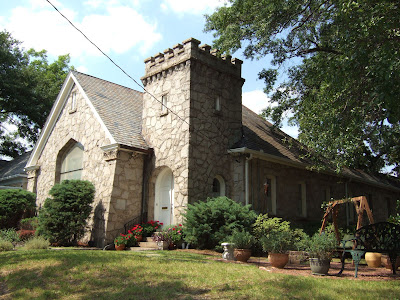 Marker Text:The plantation house of George M.T. Hurt, begun the Summer of 1962, never completed and never occupied as a residence, stood on the site of the stone church. It faced the Decatur road.
Marker Text:The plantation house of George M.T. Hurt, begun the Summer of 1962, never completed and never occupied as a residence, stood on the site of the stone church. It faced the Decatur road.
July 18, 1864. A sector of the outer line of Atlanta’s defense works was located just east of the house, which was used as headquarters by the 10th South Carolina regiment (CS) of Manigault’s Brigade.
July 22. The same troops, having withdrawn to the city the night before, returned late afternoon and attacked the Federal forces occupying the position, capturing and holding it until driven out. This is the moment shown in the Cyclorama of the Battle of Atlanta.060-97 Georgia Historical Commission erected 1956
Location: DeGress Avenue between DeKalb Avenue and the sharp turn in the road
GPS
Date Visited: July 01, 2008
This marker is in the thick of the entrenched lines fighting on the afternoon July 22, 1864. Again it describes how several brigades were withdrawn one night only to be moved back the next afternoon to attack the lines that they previously occupied.
Another scenario or rational for this feign has come to mind however. Since a full three divisions make a fifteen mile night march to attack the rear of McPherson's lines, I am sure that some troops would be needed to occupy the primary lines in place of those missing. This makes somewhat more sense to me than the other cases.
I do admit that I did look up both "troop" and "troup" out of curiosity and ignorance. Pronounced the same, do they have the same or similar meanings? No, they don't. "Troop" is a group or band assembled for a purpose such as war while "troup" is a proper now associated with people of places.
The other thing that amazes me from this marker is that the plantation house was started in 1862. That is smack-dab in the middle of this Civil War. I was always under the assumption that financial times were hard for everyone, especially in the south and especially to anyone involved in agriculture. Maybe they had to have projects like this in order to keep their slaves busy and therefore preoccupied.
Also, why do so many people in this time period have four names, including their surnames? I mean that is a mouthful...George H.T. Hurt. I am presuming that the "T" stands for Troup. It is called the Troup Hurt house.
Here is a picture of the stone church mentioned in the marker. It is now a private residence. It was up for sale a couple of years ago and my wife and I got to walk through it. Can't say that I remember much except for the stained glass and thinking that it would be like living in a church.

